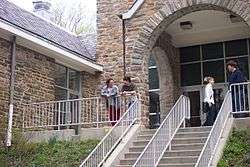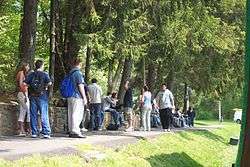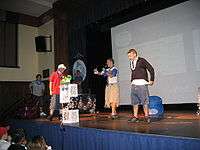Penn State Abington
| Type | Public |
|---|---|
| Established | 1950 |
Parent institution | Pennsylvania State University |
| Chancellor | Damian Fernandez |
| President | Eric J. Barron |
Administrative staff | 107 full-time |
| Undergraduates | 3,952 |
| Postgraduates | 0 |
| Location | Abington, PA, USA |
| Campus | Suburban |
| Mascot | Nittany Lion |
| Affiliations | NEAC (NCAA Division III) |
| Website | abington.psu.edu |
 | |
Penn State Abington is a commonwealth campus of the Pennsylvania State University. It is located approximately 15 miles (24 km) north of Center City Philadelphia, Pennsylvania, United States in the Abington section of Abington Township. The campus is set on 45 acres (180,000 m2) of wooded land, and includes a duck pond, wooded trails and many species of hardwood tree. The roughly 3,952 undergraduate students are taught by a full-time faculty staff of 107 professors, with the average class size being 24 students. Students participate in a wide variety of activities and many types of intramural and intercollegiate sports.
Several degree options are available at Penn State Abington. Students may complete the first two years of any of 160 Penn State baccalaureate programs at the Abington campus, and then change assignment to the University Park campus of Penn State to complete their degree. Two associate degree programs, 18 baccalaureate degree programs, and continuing education programs designed for adult students are also available. Graduate degree programs are not offered at Penn State Abington. The athletics program has been granted full NCAA Division III status.
History
The Penn State Abington campus was not originally a Penn State campus. The origins of the Abington campus begin with Jay Cooke, a banker who had financed the Union during the Civil War, and The Chestnut Street Female Seminary, a Philadelphia school for girls between the ages of 12 through 18 that opened in 1850. With increasing enrollment, The Chestnut Street Female Seminary needed to find a campus that could accommodate the larger student body.
Jay Cooke
In 1863, Cooke had constructed a lavish mansion in Cheltenham Township, Pennsylvania which he named Ogontz, in honor of a Sandusky Indian Chief from Ohio named Ogontz. Cooke had spent much time with Chief Ogontz during his childhood, and admired Ogontz greatly. In 1883, Cooke suffered financial hardship and needed a way to pay off his debts. Jay Cooke persuaded The Chestnut Street Female Seminary of Philadelphia to lease his mansion Ogontz. The Chestnut Street Female Seminary was renamed The Ogontz School for Girls after the 1883 move to Cooke's mansion and estate.

Abby Sutherland
In 1902, Radcliffe College graduate Abby Sutherland arrived at the school to take a job as an English teacher. This would begin a long association with The Ogontz School for Girls for Abby Sutherland. Eventually, Sutherland would go on to become headmistress, president, and owner of the school. In 1912, Headmistress Abby Sutherland bought The Ogontz School for Girls.
In 1916 the school's new owner Abby Sutherland began looking for a larger location for The Ogontz School for Girls. She sold the school's property in Cheltenham Township, and bought 54 acres (220,000 m2) of land in what Sutherland called the "beautiful park section in the hills of Rydal", and moved the school to Abington. At the time of the move, only the main building, known today as the Sutherland Building, had been completed. Soon after the move, the Rydal School, known today as the Rydal Building, was added to accommodate additional elementary grades.
It was at this time that The Ogontz School for Girls most famous student, Amelia Earhart, attended the school. Earhart never graduated however, leaving after two years at the school to enlist as a nurse's aide at Spadina Military Hospital in Toronto, Canada.
Penn State Ogontz
As years passed and attitudes changed, the need for the school became in doubt. In 1950 school owner Abby Sutherland gave the property and all facilities to the Pennsylvania State University, including a painting by Thomas Moran, an artist to whom Jay Cooke had advanced money in 1873. That painting is still on display today at Penn State Abington.
At the presentation ceremony to Penn State, Sutherland remarked, "Guard here the spirit of the best in your dreams of education." Sutherland continued to live on the grounds of The Penn State Ogontz Campus until her death in 1961. The Abby A. Sutherland Scholarship is given to deserving students each year in her honor.
In 1995, Penn State Ogontz was renamed Abington-Ogontz to emphasize its relationship with the surrounding community. On July 1, 1997, the Penn State Ogontz campus became a Penn State college that may grant baccalaureate degrees, and was renamed Penn State Abington. The Ogontz name lives on in the Chief Ogontz Award given by the Student Government Association to a faculty or staff member in recognition of outstanding contributions to student life.
Athletics
Penn State Abington, known athletically as the Nittany Lions, is a full member of the NCAA Division III and participates in the North Eastern Athletic Conference (NEAC) and the Eastern College Athletic Conference (ECAC).
Penn State Abington sponsors 13 intercollegiate sports. Men's sports include baseball, basketball, cross country, soccer and tennis; while women's sports include basketball, cross country, golf, lacrosse, soccer, softball, tennis and volleyball.
Facilities
Penn State Abington features a large library, modern laboratories, and computer facilities. Recreational areas include tennis courts, basketball courts, and baseball and soccer fields. There are no residence halls on campus. The major buildings on campus include the Sutherland Building, the Woodland Building, and the Lares Building. Other buildings on campus include Springhouse, the Rydal Building, the Conference Center, the Clovery Building, the Physical Education Building, and the Hillcrest Building.
The Sutherland Building was built in 1915, and was the original main building for The Ogontz School for Girls. Today it is mainly a classroom building, and features a lecture hall, academic offices, a post office, and a tutoring facility. Two interesting features of the Sutherland Building are an indoor swimming pool which is now used for storage that is located right near the lecture hall and a solarium. The inclusion of the solarium was a design decision influenced by Jay Cooke's mansion Ogontz.
The Woodland Building was constructed after the campus became part of the Pennsylvania State University. This building features classrooms and a lecture hall, laboratories, a computer lab, academic offices, the Academic Advising Center, and a library with a collection of nearly 60000 volumes. Penn State Abington's library is available for use to students, faculty, staff, alumni, and residents of the Commonwealth of Pennsylvania.

The Lares Union Building was originally built in 1923 as the personal residence of Abby Sutherland. This is the student union building on campus, and facilities include a cafeteria, bookstore, banquet rooms used for student programs, student organization and government offices, the Office of Intercultural Affairs, and the Career Development Center. The Lares Union Building underwent major renovations between 1998-2002. Renovations included a modernized dining area, a larger bookstore, and banquet rooms overlooking the duck pond. Further renovations provided a computer lab on the lower floor with a student lounge across the hall.
Penn State Abington currently leases additional office space at the nearby Rydal Executive Plaza which houses the Office of University Relations (2nd floor) and also houses academic and other offices (3rd floor).
In 2017 (projected), Penn State Abington will open its first on campus housing nearby to the campus, which will house roughly 800 students and make the campus residential instead of commuter. Along with the campus housing project, Penn State Abington is also planning on building a new student union and new academic building within the next four years.
References
- Penn State Abington website. Retrieved October 27, 2008.
- Map of Penn State Abington campus. Retrieved September 4, 2014.
- History and Development of The School District of Cheltenham Township. Retrieved March 19, 2006.
- The Ogontz White Mountain Camp a related project undertaken by Abby Surtherland. Retrieved March 19, 2006.
- Terrie Smith (September 13, 2001). Guard here the spirit. Penn State Intercom. Retrieved March 19, 2006.
External links
- Penn State Abington website
- Penn State Abington athletics website
- Penn State Undergraduate Degree Programs Bulletin (The Blue Book). Retrieved March 19, 2006.
Coordinates: 40°07′03″N 75°06′33″W / 40.11746°N 75.10914°W
| Wikimedia Commons has media related to Penn State Abington. |

